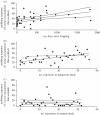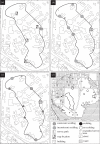Social learning spreads knowledge about dangerous humans among American crows - PubMed (original) (raw)
Social learning spreads knowledge about dangerous humans among American crows
Heather N Cornell et al. Proc Biol Sci. 2012.
Abstract
Individuals face evolutionary trade-offs between the acquisition of costly but accurate information gained firsthand and the use of inexpensive but possibly less reliable social information. American crows (Corvus brachyrhynchos) use both sources of information to learn the facial features of a dangerous person. We exposed wild crows to a novel 'dangerous face' by wearing a unique mask as we trapped, banded and released 7-15 birds at five study sites near Seattle, WA, USA. An immediate scolding response to the dangerous mask after trapping by previously captured crows demonstrates individual learning, while an immediate response by crows that were not captured probably represents conditioning to the trapping scene by the mob of birds that assembled during the capture. Later recognition of dangerous masks by lone crows that were never captured is consistent with horizontal social learning. Independent scolding by young crows, whose parents had conditioned them to scold the dangerous mask, demonstrates vertical social learning. Crows that directly experienced trapping later discriminated among dangerous and neutral masks more precisely than did crows that learned through social means. Learning enabled scolding to double in frequency and spread at least 1.2 km from the place of origin over a 5 year period at one site.
Figures
Figure 1.
Responses of lone, unbanded crows (solid symbols, scolding; open symbols, silent) at site B (urban and dense suburban Bellevue, WA; for other sites see the electronic supplementary material). Each of the 11 repeated trials in which the dangerous mask was worn is represented as a straight line with segments proportional to the actual route (lines 1–11 under the study route, letters orient lines to route; dashed lines delineate the major segments). The locations of all mobs given in response to the dangerous person's presence and the responses of all lone unbanded (never captured) crows are plotted in a spatially explicit manner for each trial. Scolding crows exposed to a mob (observed within 100 m of the location where mobbing occurred on a previous trial; these crows have a plus symbol) are evidence of peer-to-peer social learning. Scolding crows that were not exposed to a mob are evidence of social learning by observing the trapping event (trial 1), evidence of inherent scolding of a masked person (trials 2–11) or the conservative nature of our assessment (trials 2–11).
Figure 2.
Scolding of the (a,b) dangerous and (c) neutral mask at our long-term research site at the University of Washington (UW) campus. The same responses to the dangerous face are plotted as a function of real time (a) and the number of trials during which birds could witness others scolding (exposures to dangerous mask; b). Responses were obtained during the breeding and non-breeding seasons by the authors and naive observers blind to the study design. A linear model was fit to all the data (solid lines with confidence intervals; a,c). An exponential rise to maximum model was also fit to the responses to the dangerous mask (dashed line; b).
Figure 3.
Spatial increase in intensity and extent of scolding at the UW site. Locations of consistent (cross hatched circles) and inconsistent (filled circles) scolding to the dangerous mask from (a) two weeks, (b) 1.25 years and (c) 2.8 years post-trapping. Circle diameter is proportional to the number of scolding crows: smallest circles represent single crows; largest represent groups of seven crows. Solid line marks survey route. (d) Responses with scolding (filled circles) and no scolding (open circles) during the expanded search (large dashed circle superimposed on street network) carried out 2.7 years after trapping.
Similar articles
- Categorical learning between 'male' and 'female' photographic human faces in jungle crows (Corvus macrorhynchos).
Bogale BA, Aoyama M, Sugita S. Bogale BA, et al. Behav Processes. 2011 Jan;86(1):109-18. doi: 10.1016/j.beproc.2010.10.002. Epub 2010 Oct 31. Behav Processes. 2011. PMID: 20971169 - Distinct neural circuits underlie assessment of a diversity of natural dangers by American crows.
Cross DJ, Marzluff JM, Palmquist I, Minoshima S, Shimizu T, Miyaoka R. Cross DJ, et al. Proc Biol Sci. 2013 Jul 3;280(1765):20131046. doi: 10.1098/rspb.2013.1046. Print 2013 Aug 22. Proc Biol Sci. 2013. PMID: 23825209 Free PMC article. - Individual and social factors affecting the ability of American crows to solve and master a string pulling task.
Pendergraft LT, Lehnert AL, Marzluff JM. Pendergraft LT, et al. Ethology. 2020 Feb;126(2):229-245. doi: 10.1111/eth.12980. Epub 2019 Dec 30. Ethology. 2020. PMID: 33776175 Free PMC article. - Influence of Host Ecology and Behavior on Campylobacter jejuni Prevalence and Environmental Contamination Risk in a Synanthropic Wild Bird Species.
Taff CC, Weis AM, Wheeler S, Hinton MG, Weimer BC, Barker CM, Jones M, Logsdon R, Smith WA, Boyce WM, Townsend AK. Taff CC, et al. Appl Environ Microbiol. 2016 Jul 15;82(15):4811-20. doi: 10.1128/AEM.01456-16. Print 2016 Aug 1. Appl Environ Microbiol. 2016. PMID: 27260356 Free PMC article. - The evolutionary origins and ecological context of tool use in New Caledonian crows.
Rutz C, St Clair JJ. Rutz C, et al. Behav Processes. 2012 Feb;89(2):153-65. doi: 10.1016/j.beproc.2011.11.005. Epub 2011 Dec 28. Behav Processes. 2012. PMID: 22209954 Review.
Cited by
- The ability of North Island Robins to discriminate between humans is related to their behavioural type.
Barnett C, Salter M, Chevallier C, Robertson N, Berard O, Burns KC. Barnett C, et al. PLoS One. 2013 May 20;8(5):e64487. doi: 10.1371/journal.pone.0064487. Print 2013. PLoS One. 2013. PMID: 23700482 Free PMC article. - Predator or provider? How wild animals respond to mixed messages from humans.
Goumas M, Boogert NJ, Kelley LA, Holding T. Goumas M, et al. R Soc Open Sci. 2022 Mar 16;9(3):211742. doi: 10.1098/rsos.211742. eCollection 2022 Mar. R Soc Open Sci. 2022. PMID: 35308627 Free PMC article. - Social learning about dangerous people by wild jackdaws.
Lee VE, Régli N, McIvor GE, Thornton A. Lee VE, et al. R Soc Open Sci. 2019 Sep 25;6(9):191031. doi: 10.1098/rsos.191031. eCollection 2019 Sep. R Soc Open Sci. 2019. PMID: 31598321 Free PMC article. - Social dynamics impact scolding behaviour in captive groups of common ravens (Corvus corax).
Blum CR, Fitch WT, Bugnyar T. Blum CR, et al. Front Zool. 2022 Dec 12;19(1):32. doi: 10.1186/s12983-022-00477-6. Front Zool. 2022. PMID: 36503565 Free PMC article. - Long-term memory search across the visual brain.
Fedurco M. Fedurco M. Neural Plast. 2012;2012:392695. doi: 10.1155/2012/392695. Epub 2012 Jul 19. Neural Plast. 2012. PMID: 22900206 Free PMC article. Review.
References
- Grant P. R., Grant B. R. 2007. How and why species multiply: the radiation of Darwin's finches. Princeton, NJ: Princeton University
- Johnston T. D., Pietrewicz A. T. (eds) 1985. Issues in the ecological study of learning. Hillsdale, NJ: L. Erlbaum Associates
- Staddon J. E. R. 1983. Adaptive behavior and learning. Cambridge, UK: Cambridge University Press
- Marzluff J. M. 1988. Do pinyon jays use prior experience in their choice of a nest site? Anim. Behav. 36, 1–1010.1016/S0003-3472(88)80244-6 (doi:10.1016/S0003-3472(88)80244-6) - DOI - DOI
- Feldman M. W., Aoki K., Kumm J. 1996. Individual versus social learning: evolutionary analysis in a fluctuating environment. Anthropol. Sci. 104, 209–231
Publication types
MeSH terms
LinkOut - more resources
Full Text Sources


